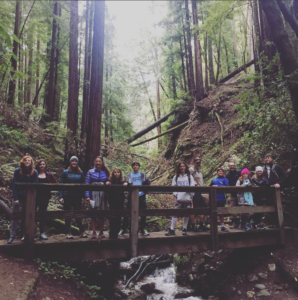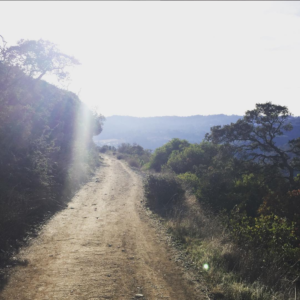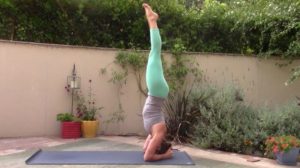Set Your Vision and Intention: A Yoga Practice

On the first day of 2017, my family and two other families went on our traditional New Year’s Day hike. We headed to the redwoods of Northern California with 8 kids in tow, and took on a 7-mile out-and-back hike. It was peaceful and meandering and it also had its moments of challenge. Since we felt so good and were enjoying nature and epic-ness of it all, we started setting intentions. Those “we should’s” or “I’m gonna’s.”
“We should do this every weekend!” my husband and I said to each other on the descent.
“This was the BEST!” said my son, Sam, who ran down sections of the trail with other boys, exhilarated.
When you have an experience that makes you feel so alive, you often wind up thinking, “Man, I feel so good! I want to do this Every, Single. Day!” That’s a form of intention. It points you in a direction. You DID the thing. You had the feeling. You got a glimpse. And that shimmer of joy provides the start of an intention.
Our moments of delight and the desires that flow from them point us toward our best self.
In the new year, it’s very natural to want to get a fresh start and to steer your life in the direction where you want to go. Setting a gaze point in front of you so that your vision aligns with where you feel most alive seems to be to be a very useful thing to do. It’s similar to setting an intention (or a sankulpa) at the beginning of a yoga practice. Whether you hit the marks you envision for yourself or not, it’s important to have an intention. Because that’s where your attention will go and your actions will follow. It’s kind of like following a map on a walk in the woods.
Where attention goes, energy flows. Where intention goes, energy flows.

In the Feng Shui tradition, one of things I’ve learned to do is to place a picture or image in front of me (at my desk, etc.) that represents where I want to go. Sometimes, I didn’t know EXACTLY where I was going, so I used a picture in front of me like the one above. A road or a path in front of me, leading me somewhere into my vision. When gazing at it, I was able to feel like I was moving forward, putting one foot in front of the other, trusting that the path would open for me as it would. “Proceed as the way opens,” as the Quakers say.
Here are some simple ways you can draw the setting of your vision and intention into the manifestation of your physical asana practice:
1. Turn your gaze inward.
Close your eyes. Just the act of closing your eyes (or lowering the eyelids so the eyes are open just a sliver) will naturally allow you to more easily focus on your breath and to pay attention more closely to your thoughts and to how your body feels.
2. Look in the direction you want to go.
For example, when stepping or especially hopping forward from Downward Facing Dog into a Standing Forward Fold (Uttanasana) try looking forward PAST their thumbs. Just setting the gaze a little further forward can sometimes miraculously result in the feet getting close to the hands in this transition.
3. Align your spine
Practice aligning all of the centers of energy (the chakras) from the root of your pelvis up to the crown of your head. This connects your highest vision (Crown Chakra) to the manifestation of that vision in the physical world (Root Chakra) and all the points in between. Twisting actions around this center line (as in Pavritta Utkatasana, Pavritta Pasvokonasana, or any of the revolved or twisted asanas) will help you connect with rotating and moving around the very center of yourself.
4. Change your perspective with inversions
Go upside down! Be adventurous! See the world from a different place! You might use the sequence below, which leads toward Headstand and Shoulderstand as a framework. This has the added benefit of making sure you focus on proper alignment to ensure your safety. Work with an experienced teacher if these poses are not in your normal repertoire. And remember that Downward Facing Dog and Legs Up the Wall are also poses that reverse the flow of energy as inversions do, and they are appropriate for most yoga students.
5. Use a single word as a mantra as you practice
Choose a word (or two) to represent your intention and keep it with you as you practice. At the beginning of your practice, pull this word into your consciousness as you take the first few breaths in your practice, and set this as a sankulpa (intention). Whenever you come to a pause in your practice, you can come back to this word(s) to call them back. As often as you can. Revisit them again as you awaken from Savasana.
Yoga Sequence to Align Your Vision & Intention
Align the vision of your life with the reality of your yoga practice with this sequence to work toward the strong and integrated inversions Sirsasana I (Supported Headstand) and Sarvangasana (Shoulderstand) by setting an intention and working toward that intention through the energy centers in your body. Let’s go!

Warm Up (stretch hamstrings, open hips, engage core, and do a little twisting)
Supta Padagusthasana Cycle (1, 2, and 3)
Jathara Parivarttonasana (with bent knees, 3x each side)
Roll up to sit –> cross ankles to come to All 4s –> Downward Facing Dog –> Uttanasana
Main Part of Flow
Surya Namaskar A with low lunges, and step back to Downdog –> jump forward into a seat –> Navasana –> Ardha Navasana –> Navasana –> cross ankles, lean forward, GAZE forward, then step back to Downdog or jump into Chaturanga and continue through Vinyasa –> from Downdog look FORWARD past your thumbs and step/float to Uttanasana
Utkatasana –> Parsva Utkatasana (both sides) –> Fold –> Step back to lunge –> Open Lunge Twist –> Warrior 2 –> Psarita Padottonasana –> {walk to lunge facing the back of the mat} –> repeat Open Lunge Twist –> Warrior 2 on second side facing the back of the mat
Utkatasana facing back of mat –> Parsva Utkatasana –> Open Lunge Twist –> Parsvottonasana –> Revolved Trikonasana –> Windmill arms and parallel feet for Psarita Padottonasana with hands bound behind –> fold –> {walk to lunge facing the front of the mat} –> repeat standing pose sequence on the 2nd side facing the front of the mat –> After Revolved Trikonasna, step back to Downdog.
Inversions
Rabbit Pose –> Balasana OR Downdog OR Sirsasana 1 (Headstand) –> Downdog
Twisting, Hip Opening, Forward Folds
Bhadvajasana
Marchiyasana
Pascimottonasana
Setu Bandha Sarvangasana –> Shoulderstand
Closing
Sukasana –> Fold
Knees to Chest
Savasana
TIP: Working on Headstand? Join me for this FREE class to work toward the actions of Supported Headstand in your practice. Enjoy!
What’s Your Word?
INTEGRATE is my “word” for 2017. To me, it means a coming together of the foundations of what I’ve learned teaching and practicing for the last 6 years and of finding a new plateau to stand on. I know very clearly where I want to go in my life, but sometimes that doesn’t make easier to make happen. It’s like struggling with a yoga pose that is alluding me. I just have to show up, to keep practicing, to continue breathing and being compassionate with myself and to be inspired by others on the mat (of off!) next to me. To integrate that next piece of the puzzle that comes to me so it becomes an embodied part of my life.
Do you have a word (or two) that can set your intention for 2017 (or for the time being at least)? Do tell!!

 Empowering women who are 40+ to install movement habits that are nourishing, strengthening, and approachable for a truly calm and connected life.
Empowering women who are 40+ to install movement habits that are nourishing, strengthening, and approachable for a truly calm and connected life.